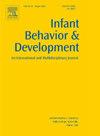Infants' saccadic behavior during 2-dimensional displays of a bounce
IF 1.9
3区 心理学
Q3 PSYCHOLOGY, DEVELOPMENTAL
引用次数: 0
Abstract
The study examined the saccadic behavior of 4- to 10-month-old infants when tracking a two-dimensional linear motion of a circle that occasionally bounced off a barrier constituted by the screen edges. It was investigated whether infants could anticipate the angle of the circle’s direction after the bounce and the circle’s displacement from the location of bounce. Seven bounce types were presented which differed in the angle of incidence. Three of the seven bounce types showed physically implausible bounces. Saccades that started before the infant could perceive the bounce and ended after the bounce were analyzed. Infants’ saccades matched the circle’s displacement with sufficient accuracy to conclude that they made predictive saccades. Only results from two bounce types where the circle’s speed was less than 12.5°/s allowed for the possibility that infants made reactive saccades. The infants’ anticipated angle was close to the angle of the circle’s direction after the bounce. When the circle was moving at 40°/s, the difference between the two aforementioned angles was less than 15°, but it increased as the circle became slower. The effect of age on the saccade targets and other object-tracking measures was small and mostly masked by a large estimation error. Estimates of the saccade amplitude, saccade frequency, and the gaze-circle displacement were similar to those observed for saccades made when no bounce occurred and they were also similar to those reported in previous studies of infant object tracking with similar trajectories but without a barrier.
婴儿在二维弹跳时的跳动行为。
这项研究检查了4到10个月大的婴儿在追踪一个偶尔从屏幕边缘构成的障碍上反弹的圆圈的二维线性运动时的跳动行为。研究了婴儿是否能预料到圆在弹跳后的方向角度和圆在弹跳位置的位移。七种不同入射角的弹跳类型。七种反弹类型中有三种表现出物理上难以置信的反弹。在婴儿能够感知到弹跳之前开始并在弹跳之后结束的扫视进行了分析。婴儿的扫视动作与圆圈的位移匹配得足够精确,因此可以断定他们进行了预测性扫视。只有当圆周速度小于12.5°/s时,两种弹跳类型的结果才允许婴儿进行反应性扫视的可能性。婴儿的预期角度与弹跳后圆的方向角度接近。当圆以40°/s的速度运动时,上述两个角度的差值小于15°,但随着圆的速度变慢,其差值增大。年龄对扫视目标和其他目标跟踪度量的影响很小,而且大多被较大的估计误差所掩盖。对扫视幅度、扫视频率和注视圈位移的估计与没有弹跳时所观察到的扫视相似,也与先前对具有相似轨迹但没有障碍物的婴儿物体跟踪的研究报告相似。
本文章由计算机程序翻译,如有差异,请以英文原文为准。
求助全文
约1分钟内获得全文
求助全文
来源期刊

Infant Behavior & Development
PSYCHOLOGY, DEVELOPMENTAL-
CiteScore
4.10
自引率
4.80%
发文量
94
期刊介绍:
Infant Behavior & Development publishes empirical (fundamental and clinical), theoretical, methodological and review papers. Brief reports dealing with behavioral development during infancy (up to 3 years) will also be considered. Papers of an inter- and multidisciplinary nature, for example neuroscience, non-linear dynamics and modelling approaches, are particularly encouraged. Areas covered by the journal include cognitive development, emotional development, perception, perception-action coupling, motor development and socialisation.
 求助内容:
求助内容: 应助结果提醒方式:
应助结果提醒方式:


